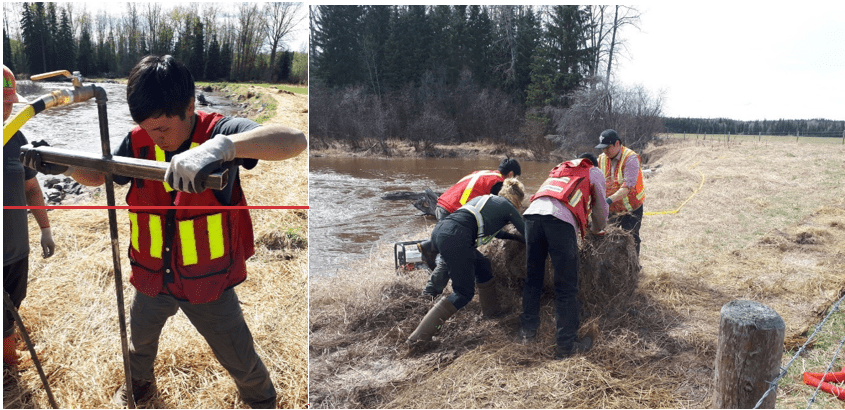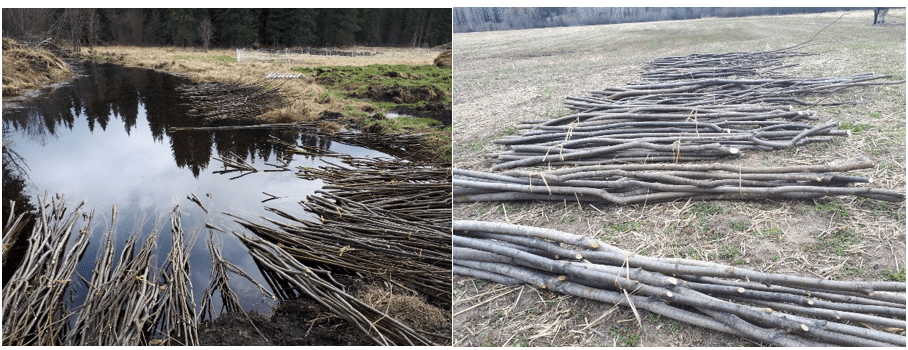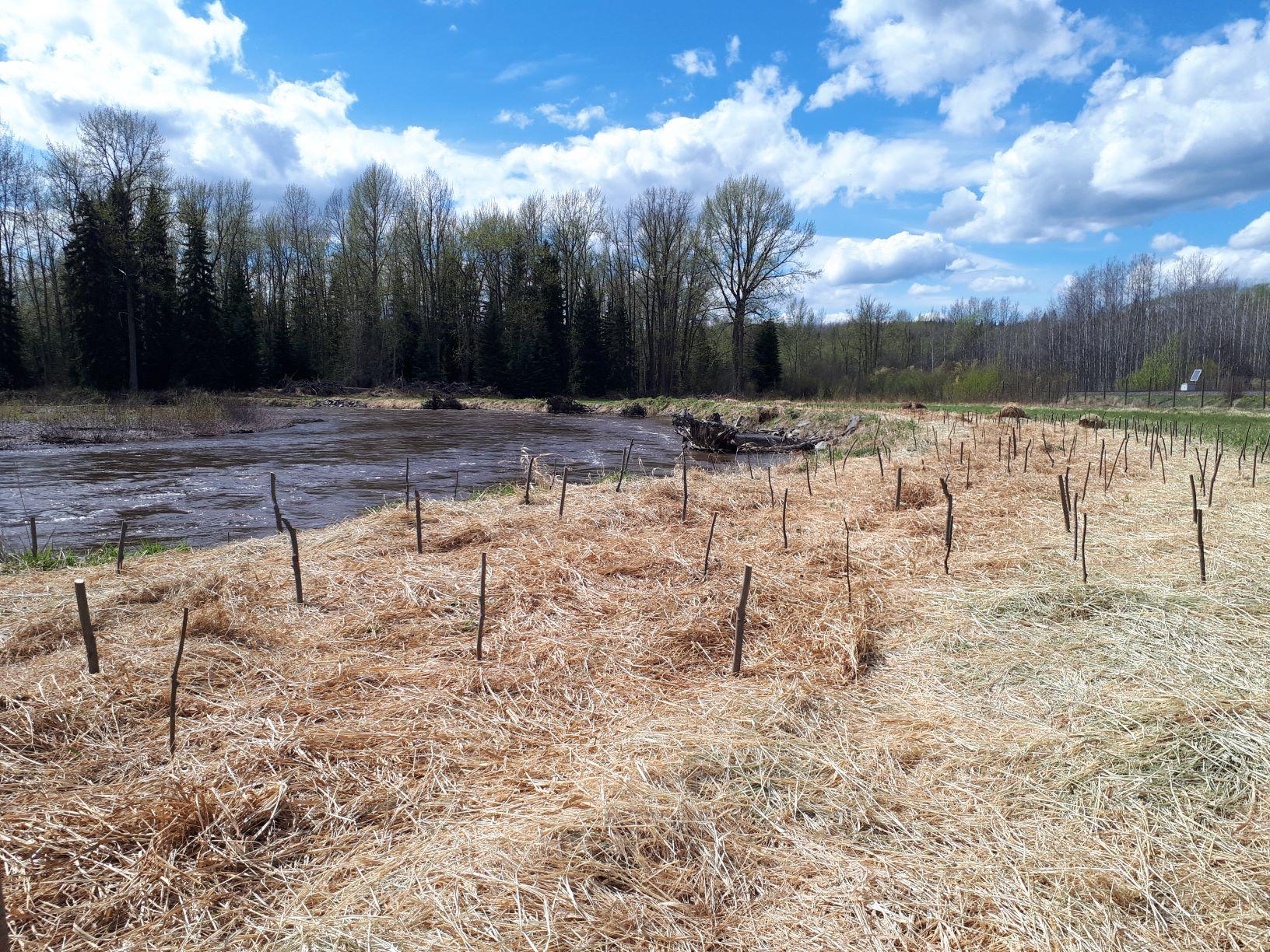Low-tech approaches to watershed management - Bulkley-Morice Water Sustainability Initiative
The concept of low-tech approaches has been known for decades but wider implementation and specific examples of successful implementation are less known.
Low-tech process based restoration techniques are a practice of using simple, cost-effective non-engineered structural additions of natural materials to restore river processes and the values those processes bring. Process-based restoration projects are reducing erosion, creating and maintaining wildlife and fish habitat, saving cropland, and increasing flood resilience.
The Morice Watershed Monitoring Trust (MWMT) in collaboration with Northwest Research and Monitoring Ltd. and A Rocha Canada is focused on developing an innovative, “low-tech, process-based” approach to watershed restoration that lets the river do the work through natural processes such as erosion, deposition, scour and movement. One such project funded by the Healthy Watersheds Initiative is the Bulkley-Morice Water Sustainability Initiative project.
This project is aimed at riparian restoration work through streamside planting and implementation of low-tech streambank stabilization solutions for the Upper Bulkley River watershed which is experiencing high land-use and climate change impacts resulting in a decline in watershed health. The focus is on promoting healthy communities and creating a longer-term plan for more restoration work in subsequent project phases, taking advantage of synergies with other past and planned watershed management projects in the Upper Skeena led by First Nations, environmental non-governmental organizations (ENGOs), and provincial and federal governments.
The MWMT is a purpose Trust for the benefit of the Wet’suwet’en people. This project is part of a broader plan to create a multi-year, science-based watershed restoration program that is focussed on their traditional territories.
Work in the Upper Bulkley began by engaging landowners to work together to stabilize streambanks and rebuild riparian structure. Establishing relationships and initiating dialogue with landowners and ranchers in the area about watershed health, river health, and community actions leads to shared outcomes where both ranchers and the environment benefit together. Dialogue has been welcomed on how to manage river corridors so that ranchers and farmers have benefits not only for their crops, but also that their actions are leading towards a healthy riverscape,

To get this work started, Project Coordinator, Laura Guillon says “An online training session on riparian planting as a low technology restoration technique was delivered by Polster Environmental, who are BC experts and pioneers in the field of bio-engineering. event encompassed all the project team, including an Indigenous field crew, numerous potential collaborators. and interested government staff. Additional mentorship and training on other aspects of streambank stabilization took place in the field.”
An initial live staking program was completed in the spring using waterjet stingers built by project contractor, Adam Wrench. A waterjet stinger is a tool used to plant dormant unrooted cuttings of willows, cottonwoods, dogwoods, and other species. The waterjet stinger is simple to operate and transport. Minimal training is required, and it helps to plant a large number of cuttings in a short period of time. The initial live staking was very successful at several high priority sites and provided valuable information for future riparian planting. Approximately 4000 Willow stakes were planted across four sites that had previous log revetment work completed (LGL). The waterjet stinger is available for future community use through the MWMT.

“Work occurred very efficiently, with harvesting and clipping followed by planting in a repeating sequence. Crews worked very well with the equipment and stated that they found the work enjoyable. Live staking using the waterjet stingers proved low hazard work requiring little special technique, making it ideal for use with volunteer groups and landowners.” Adam Wrench, Upper Bulkley landowner and restoration project contractor, Northwest Research and Monitoring Ltd.

In the fall, six sites located on four properties received low-tech streambank restoration -. Stabilization began by re-sloping selected banks to a gentler slope and laying down erosion matting of cotton thread with straw. Posts were driven down below the watermark to provide vertical structure to pin the bank in place and Willow wattle fences woven along the posts. Rooted Willows and additional live-stakes were planted in between the posts. On one property, a fence line was moved to protect the riparian zone from cattle.
For effectiveness monitoring, willows planted in the spring were evaluated in fall in terms of survival, condition, growth, and root development. It is expected that the root development on willow cuttings with good vigour will penetrate the soil more deeply and more quickly than other types of riparian vegetation (shrubs and grasses), resulting in better streambank stability. Further monitoring occurred this year via drone imagery and on the ground surveys. Updates to this work will be posted on the project website, bulkleymoricewater.com.

Our Healthy Watershed Initiative team visited the Bulkley-Morice Watershed Sustainability Initiative recently and met with some key people who are making this project come to life.
- Cindy Verbeek (A Rocha Canada Northern BC Coordinator)
- Ian Sharpe (MWMT trustee and restoration project implementation coordinator)
- Marvin Strimbold – Landowner
- Roger Groot – Landowner
Cindy Verbeek - Outreach Coordinator, A Rocha Canada, is acting as a community liaison, connecting with landowners, organizing field events to invite landowners, video workshops, lots of people, low tech restoration methods.
Cindy’s perspectives on low tech technologies – “This project has been great because it is low-tech and hands on which landowners were familiar with, and it allowed them to be involved in the work, it was the attitude change that has been great.”
Cindy Says “I feel like this is really important because coming to a new era where people wanting to live with the created world in a way which is healthy for both their families and for generations into the future, this project is really one of those projects where you do something now and you know that you are doing something to improve for the future and for your children and for the natural world.”
Ian Sharpe - Trustee of the Morice Watershed Monitoring Trust, Technical Coordinator
“This work is important for many reasons, so if you think of land use and climate change working together as an accelerator of ecosystem change, you realize that we are basically at a now or never moment. There is opportunity because we are finding a lot of collaborative support and participation with local landowners, and regulators and so this is a unique moment where we can get this work going.” Ian Sharpe – Trustee of the Morice Watershed Monitoring Trust, Technical Coordinator
Marvin Strimbold - Landowner
“I'm a fourth generation living on the Upper Bulkley, so quite a history. Over the last 20 years we've been doing quite a bit of work along the creek and valley bottoms and so [the project] is exciting for the future, for our kids, our grandkids… The wish would be that we continue to be able to farm and harvest along the valley bottoms. I think we need to continually grow with the river, learn from our mistakes, but also learn and try new things. It’s a long-term process.”
Roger Groot – Local Rancher
“It is huge for us, for crops and cattle, maintaining water levels helps our crops and cattle for watering and for wildlife (migratory birds), habitat for wetlands, everything is all part of it. “
Rick Budhwa - Principal, Northwest Research and Monitoring Ltd.
"Yintah is the Wet’suwet’en philosophy which states that everything is connected to the land. So when we restore the land we are improving and restoring spiritual, moral and cultural benefits to the people.”








